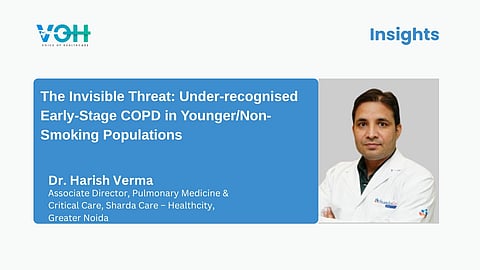

For many years, Chronic Obstructive Pulmonary Disease (COPD) was perceived almost solely as a "smoker's disease" or a natural occurrence of aging. We are now at an unfortunate juncture, where that misconception is harming a brand-new, younger cohort of people—people who may have never even smoked a cigarette.
COPD is a spectrum of disease that includes chronic bronchitis, emphysema, and some forms of long-standing asthma. These conditions narrow the airways, damage the lungs, and cause ongoing breathlessness that can worsen over time if untreated.
In my clinic, I’m now seeing more patients in their 30s and 40s who have early lung problems, even though they’ve never smoked. These early signs are often missed or not taken seriously.
The New Risk Factor: Beyond the Cigarette Pack
The "old story" of COPD is no longer working in the context of modern life. While smoking is still the most common cause in the world, it is not the only cause. For the younger population or the non-smoking population, the bad guy is often the air they are breathing, either outdoors or indoors.
Outdoor air pollution.: Living in our cities exposes us to a mix of vehicle exhaust, industrial fumes, and fine particulate matter. Breathing this polluted air every day can trigger chronic inflammation and cause damage to the small airways and lung lining, similar to the effects of smoking.
· Indoor Air Pollution: For lots of homes, especially in developing parts of the world, the problem is indoor air pollution. Smoke produced from using biomass fuels (wood, dung, crop residue) for cooking, along with insufficient ventilation, is a primary contributor, notably affecting women. Even continual exposures to incense sticks, mosquito coils and other similar things can also have a significant impact over time.
· The Silent Symptoms : The Challenge of Diagnosis
Perhaps the most significant challenge when it comes to early COPD development in this population is that symptoms are usually obscure and can easily be rationalized to be something other than early symptoms of COPD.
The young, non-smoking person with early COPD does not have life limiting, severe breathlessness seen with later stage diagnosis. In fact, they might simply experience:
· A persistent, mild cough known as ‘smoker’s cough’ even in a non-smoker, blamed on a lingering cold or allergy.
· Feeling “out of shape” earlier than their peers; they find themselves, unintentionally, taking the elevator now instead of the stairs or making excuses not to act briskly up in their exercise tolerance. Instead of questioning reasons, they publicly blame age or extra weight.
· Frequent chest infections that take longer to completely resolve.
Often when a young, seemingly active, and healthy non-smoker describes these minor complaints, Physicians often consider either early asthma or infections—completely overlooking COPD . leading to ongoing, unnoticed progression of lung damage.
Time for Check-your-lungs: The Next Steps
We must change how we think about COPD. It’s not just a “smoker’s disease.” Many non-smokers can develop it too, and it’s becoming more common in people who are exposed to pollution or other risks.
The key is early intervention. If you, or someone you know, has a cough that lingers for more than one month to report or has experienced a notable decrease in exercise tolerance, please do not ignore this. Ask a Physician to perform a simple, non-invasive test called Spirometry.
Spirometry gauges your ability to exhale passively and exhale quickly, and it is useful in detecting the earliest signs of airflow limitation. When we diagnose you with COPD early, before respiratory symptoms alter your behaviours and everyday routine, we can help initiate therapies and lifestyle changes that can greatly attenuate the progression of the disease.
The future of lung health is no longer just about the crisis point, we must listen to the quiet whispers of our own bodies. Be mindful of your breath, and when something doesn't feel right, demand an explanation. Your quality of life depends on it.
Also Read